By Maria Gritsevich, Peter Jenniskens, and Paul Roggemans
When Esko Lyytinen heard about the start of MeteorNews at the beginning of 2016 he was among the first to respond, to support and to encourage the new initiative with a report about a fireball over Finland (Lyytinen, 2016a). Later that year Esko published an article about his October Camelopardalis outburst model (Lyytinen, 2016b). Whenever advice was asked for reviewing articles in MeteorNews or about outburst predictions, Esko always replied quickly, providing plenty of information, always eager to discuss topics in detail. In 2019 Esko sent a draft for an article about the likely alpha Monocerotids outburst on the morning of November 22, 2019 (Lyytinen and Jenniskens, 2019), when the article was already online, he was still working to improve his ephemerids and asked to include some last-minute updates of the article. The article on MeteorNews caught the interest from CNN, National Geographics, etc. and got an exceptional attention worldwide. The predicted alpha Monocerotids outburst did materialize, be it less spectacular than what the media had suggested (Roggemans et al., 2020). Esko planned to look up a number of other past outburst predictions to highlight these in MeteorNews but needed to find some time to check his notes and calculations.
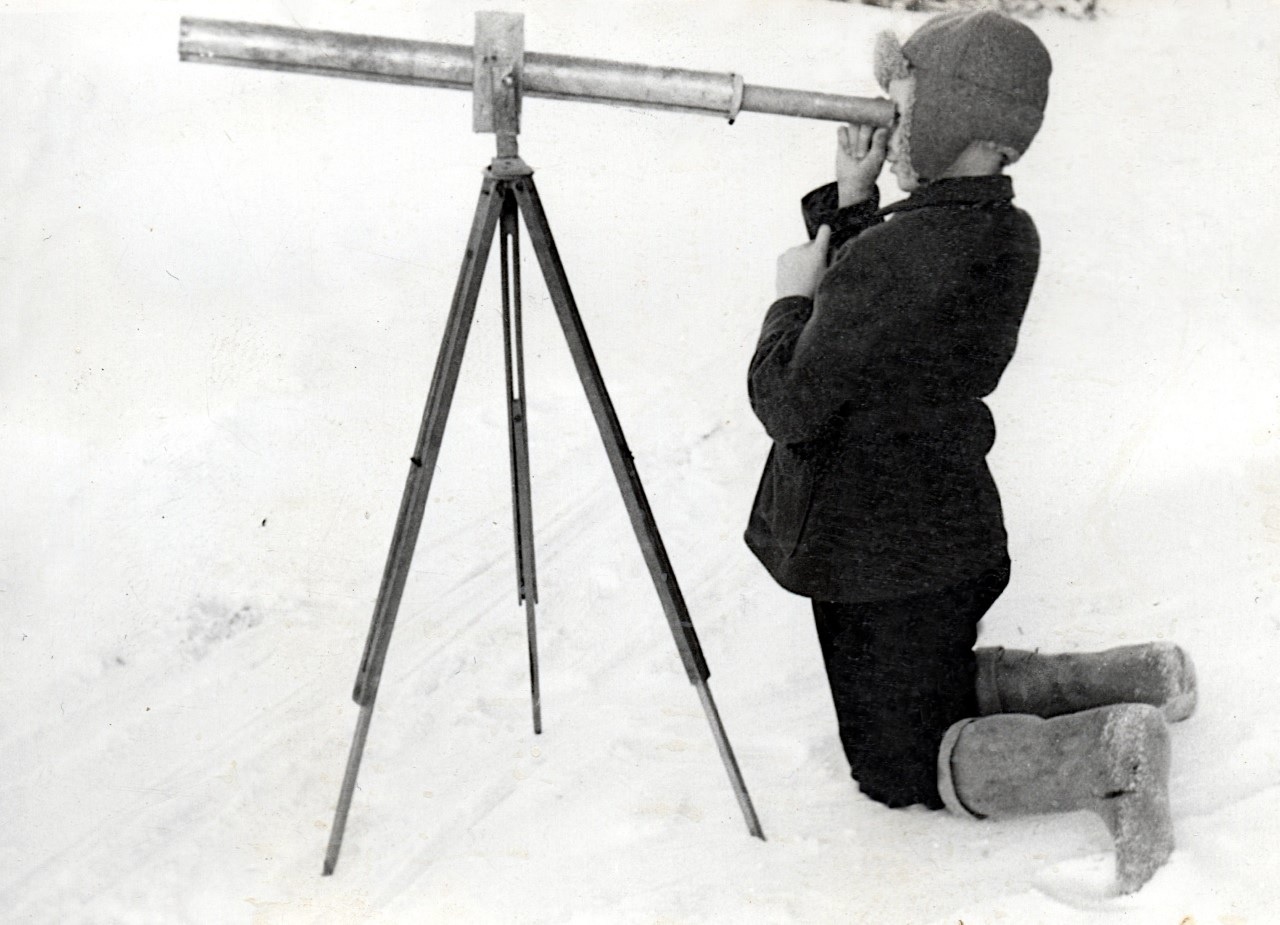
Figure 1 – Esko on the photograph titled ‘my first telescope’ (source: Esko’s own photograph album).
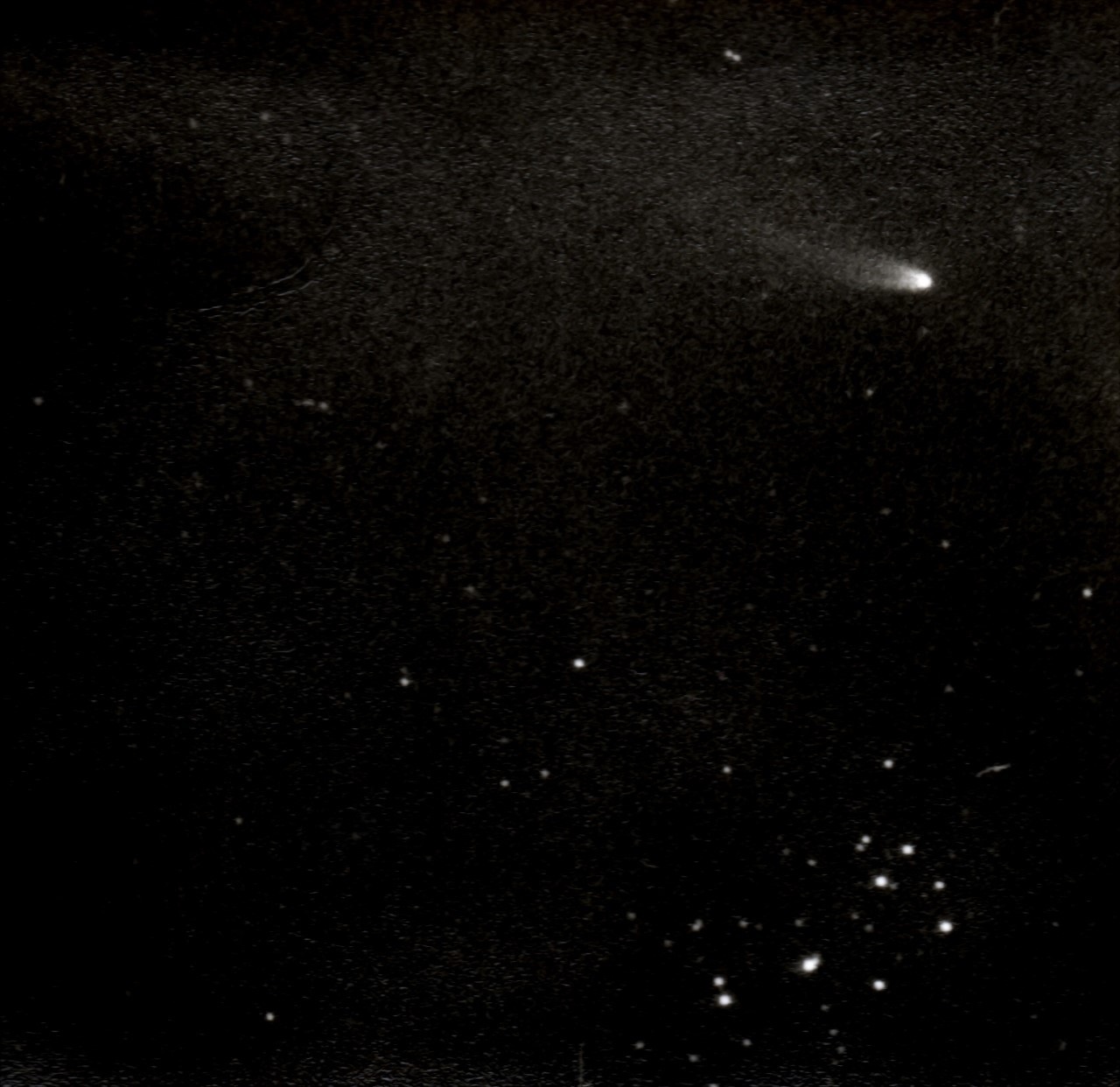
Figure 2 – Photograph of the comet Seki-Lines of 1962 (photo taken by Esko on 16 April 1962, source: Esko’s own photograph album).
On Christmas Eve 2020 Esko Lyytinen, 78 years old, passed away at the Malmi Hospital in Helsinki following sudden heart surgery and the planetary science community lost one of the most dedicated and passionate meteor researchers.
Esko Lyytinen was born on 6 November 1942 in Helsinki, Finland. He lived most of his childhood in Kuru, today part of Ylöjärvi. His family moved to Helsinki in the 50s, where Esko lived for the rest of his life. His father taught and worked in forestry and public administration. His mother had a Master’s degree in biology and natural sciences and was a teacher for a short time, before she devoted her life to the family and bringing up the children.
A deep love of nature was very much part of the family ethos.
From a very early age Esko was fascinated by the stars and the universe. Esko was 14 when the Earth’s first artificial satellite, Sputnik 1, was launched in 1957 and already at that age he could figure out exactly where and when to look to see it in the sky. He would get the whole family to look at it the very first night it was visible. While for the rest of the family it was a one-night spectacle, Esko continued observing it as well as subsequent satellites. It may come as no surprise then that years later he named his first model of meteoroid stream formation “the satellite model of comets” (Lyytinen E., 1999).
He outgrew his very first telescope quickly and built his own reflecting telescope. He ground the main mirror himself and managed to source an eyepiece. He built the frame with whatever leftover planks he could find. It was not pretty but it worked. Its scruffy appearance did not stop it being placed in a prime spot on the small balcony in the family’s home. This inventive approach would be repeated many times with the various other contraptions he created throughout his life. Antennae, cameras, directional microphones, metal detectors and so on would be taped or glued together with whatever spare objects he could find or source to get the job done. Wherever they needed to go, be it the front of the house, on the roof, installed on a laptop, or literally attached to his own forehead, the look did not matter as long as the concept worked.
Esko’s interests in photography, astronomy and amateur radio converged in the 60s when he started receiving weather satellite imagery with his equipment. This was at a time when others would see such images only rarely printed in newspapers. Esko was always extraordinarily capable of applying and combining his fields of knowledge to new problems and filling in the gaps by persistently educating himself.
While the far distance of space fascinated Esko, he was not enthusiastic about traveling long distances back on Earth. In November 1998 Esko had chosen to holiday with his family at Madeira over a ‘meteor storm chasing’ trip to China at the time when the Leonid meteor shower was predicted to peak and be most visible. He believed that his holiday location was far from the ideal spot to observe the Leonids; the peak of the shower was calculated to be at a time when the opposite side of the Earth was facing the dust trail that produced it. Nevertheless, Esko got up that night and to his surprise, and against the predictions, he was treated to a spectacular meteor shower, not only visible from an area not predicted but also earlier than expected.
As it turned out, the shower had peaked earlier than predicted and Esko was close to an ideal location to observe it. He was perplexed at how inaccurate and far “off-schedule” the predictions had been and set his mind to developing better comet dust trail models on his home computer. Soon after that, Esko indeed came up with an independent model of the formation and evolution of dust trails from comets (Lyytinen, 1999).
Esko went on to successfully forecast and (post)-predict many meteor outbursts. His dust trail predictions yielded many important publications, including improved 2001 Leonid storm predictions from a refined model (Lyytinen et al., 2001). The work was continued and for the 2003 and 2004 predictions Esko teamed up with other researchers. Hence, different models were compared with older cometary trails (Vaubaillon et al., 2003). In the following years, much work was done to try to improve the predictions using possible changes from radiation pressure. Observed ZHR values were quite low, but different predicted dust trail encounters could indeed be recognized in the observations (Vaubaillon et al., 2004; Trigo-Rodríguez et al., 2006).
In 2000, Esko started a very fruitful collaboration with meteor astronomer Peter Jenniskens that led to 33 co-authored publications. “I first interacted with Esko leading up to the 2000 Leonids,” recalls Jenniskens. “Esko analyzed the effects of radiation on the moving particles, which moved the dust trails near Earth’s orbit enough to cause quite different predictions that year.”
“Later that year, the Ursid meteor shower was expected to show an unusual meteor outburst, which occurred when the parent comet 8P/Tuttle was at aphelion, and Esko worked out why that was. We published our predictions of the peak time in Jenniskens & Lyytinen (2000) and the outburst was confirmed (Jenniskens & Lyytinen, 2001; Jenniskens et al., 2002).” Calculations on the Ursids by Esko and Markku Nissinen were published in a table in Jenniskens’ book “Meteor Showers and Their Parent Comets” (Jenniskens, 2006; Jenniskens et al., 2006).
“In the following years, I directed Esko’s attention to long-period comet dust trails, like the one that caused the alpha Monocerotid outburst in 1995. Again, Esko was able to model key features of the observations. His results on long-period comets were published in the journal Icarus (Lyytinen & Jenniskens, 2003). Ever since I have turned to Esko for future predictions when a new long-period comet shower was seen. Esko predicted a shower from comet C/1976 D1 (Jenniskens & Lyytinen, 2003) and I traveled to South Africa to try to confirm that, but the weather and far southern declination of the radiant proved too big a challenge. Even this campaign led to greater collaborations. Examples being studies of the October Camelopardalids and the 2008 September Perseids (Jenniskens et al., 2005, 2006, 2008). Most recently, Esko found a clever way to use meteor shower observations to measure the orbital period of poorly observed long-period comet Grigg-Mellish (Jenniskens et al., 2020).”
With the return of comet 8P/Tuttle in January 2008, close to the 2007 encounter, further modeling of the Ursid shower was carried out. In addition, there was even a prepared airborne observing campaign from NASA Ames Research Center to observe the Ursid shower over the Canadian arctic. This was fascinating and very inspiring for Esko to follow (Jenniskens et al., 2007). This work found there were two predicted encounters with old trails, from years 1466 and 1533 and they were coinciding in time. The trail of 1466 produced an outburst in 2008. This allowed Esko to update the prediction by running the model with the increased number of particles (Lyytinen and Nissinen, 2009; Vaubaillon et al., 2009a, 2009b).
When comet 17P/Holmes exploded in October 2007, Esko immediately realized the possibility to observe the dust trail produced by the explosion in the future. In the ‘Tähdet ja Avaruus’ article of the comet explosion Esko suggested that a phenomenon “shaped like an hour-grass” may appear at the explosion site at the next revolution of the trail. Esko expected that this phenomenon may be a vivid reminder of the past explosion event. Unfortunately, the phenomenon was too dim to be seen without a powerful telescope and this did not prove to be as amazing sight for the public as had been hoped, compared to if the trail would have been much brighter and easier to see (Lyytinen et al., 2014; 2015). When the material from the explosion had travelled half revolution to the other common node of the particle’s orbits Esko and Markku Nissinen had succeeded in observing the phenomenon in the southern sky using remote controlled telescopes at the Siding Spring Observatory in Australia (Lyytinen et al., 2013a, 2013b).
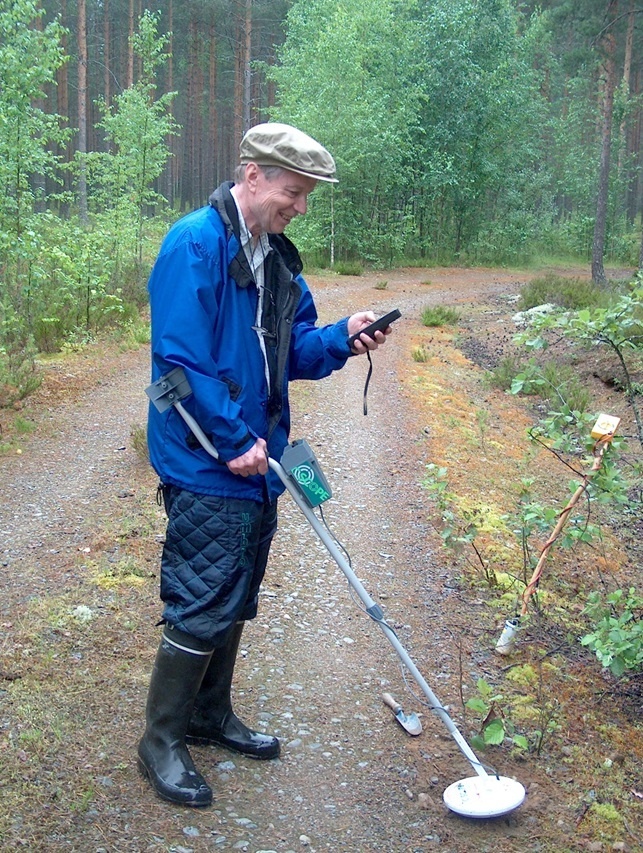
Figure 3 – Photograph of Esko made in July 2004 near Savonlinna, in Eastern Finland. The picture is taken during the comparison test with metal detectors — a commercial version (which Esko is holding) and the metal detector which Esko had made himself (on the ground). (Images credit: Markku Nissinen).
The hobby-motivated research soon made Esko famous in the meteor, and later, in the planetary science community. In 2003 Esko was invited to review and serve as an opponent of the PhD thesis defended by Jérémie Vaubaillon in the Paris Observatory in France (Esko declined the invitation for personal reasons). Later (in 2014) the International Astronomical Union (IAU) named the asteroid 15699 Lyytinen (1986 VM6) to highlight his long-term outstanding contribution to planetary science (A new proposal has been put forward to exceptionally name the Swedish iron case observed on November 7, 2020 following the last Esko’s birthday on this planet as Esko Lyytinen. The present article comprises a lot of justifications for that exceptional reasoning. Even if not achievable, that will be an association that we will always carry with those of us who knew and worked with him.). Often, he would be contacted concerning the annual shower calendar as well as his model calculations that he could graciously perform for meteor showers. Esko would readily share findings about meteor events he had analyzed as well as his ideas on meteoroid stream evolution.
It was while he was up at his summer house in the small town of Vesanto in central Finland that Esko would engage in his latest attempts of pushing both radio and video methods of meteor detection. His temporary modification of his video camera to push the infrared end led to fascinating videos of nocturnal birds and waterfowl migrations and aurora. Although these may not have always been the results, Esko was looking for the most; they were unique and charming nonetheless. Esko was a true tinkerer as seen in a photo of a bay of UHF antennas duct taped to a hockey stick. Despite its comical look, it allowed Esko to pursue his goals quicker and, as always, it worked.
Esko was always eager to testing, using or even improving the software with his brilliant ideas, be it the ‘α-β model’ (Gritsevich 2009; Lyytinen and Gritsevich, 2016), orbit determination with ‘Meteor Toolkit’ (Dmitriev et al., 2015a; 2015b) or anything else. In fact, the diversity of different ideas and tools that Esko had used, and developed will significantly impress many.
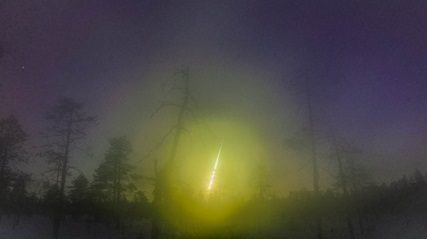
Figure 4 – The Annama fireball — leading to the first meteorite recovery based on the Finnish Fireball Network observations. Photo from Kuusamo, Finland on April 19th 2014. (Image credit: Asko Aikkila).
Esko would gladly engage in complex video calibration of any unknown camera if it happened to capture an interesting meteor case in any part of the world (Lyytinen and Gritsevich, 2016a; Trigo-Rodríguez et al., 2015; Hildebrand et al. 2018; Larionov et al. 2018; Meier et al., 2020). In fact, when we received a physical dash-cam that captured the daylight Osceola fireball in the US, its robust study with stars on Finnish skies practically did not improve on Esko’s previously made remote calibration of the camera.
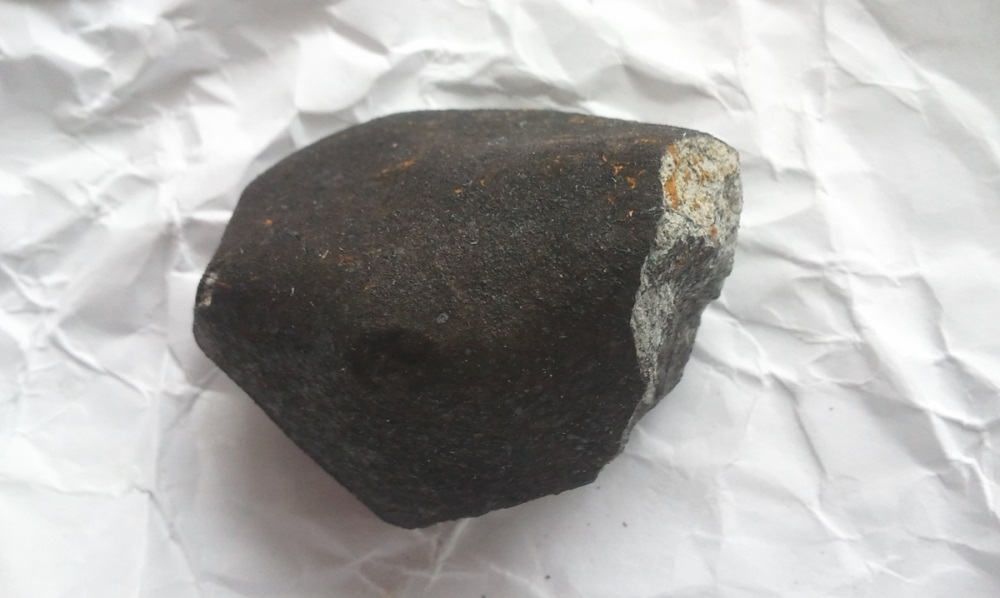
Figure 5 – The photograph of the first recovered fragment of the Annama meteorite taken by Esko the same day as it arrived to Finland, 1st of June 2014 (Esko biked to MG the same day to see the sample and this is when he used his phone to make this picture of the sample lying on the kitchen table). The sample was later given to the Ural Federal University meteorite collection in Russia.
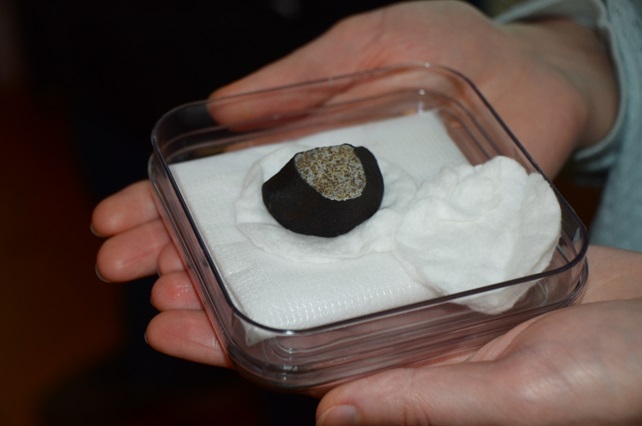
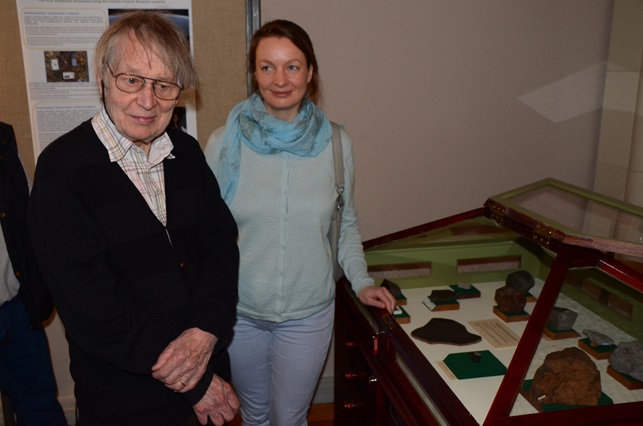
Figure 6 – Top: The photograph of the second recovered fragment of the Annama the day it was donated for the display at the Finnish Museum of Natural History. Bottom: Esko Lyytinen, Maria Gritsevich and the Annama meteorite fragment just placed on the museum display. (Images credit: Jarmo Moilanen).
Various smart techniques were proposed by Esko in processing meteor observations, including the height correction method to account for real atmospheric conditions (Lyytinen and Gritsevich, 2016b). Similarly, the atmospheric refraction correction method allows for retrieving a fireball position with high accuracy without the need to consider at which distance from the observer (or height above the Earth’s surface) the fireball is situated (Visuri et al., 2020).
Finland is a relatively small and not well-populated country, with an area elongated from south to north of ~338000 km². It is Europe’s most heavily-forested country and subsequently it has one of the most difficult terrains for meteorite recovery. In addition, Finland’s water area is vast: 187888 lakes and ponds with an area of more than 500 m², as well as a total of 25000 km of rivers. The total area of water bodies takes ~10% of the area of the country and forests take ~74% of the land area. Despite the effort, no meteorites from the observed falls were recovered in Finland within the last 50 years. Out of the 5 historically witnessed meteorite falls (and a total of 13 meteorite falls), the last one, Haverö, was collected in 1971.
Despite this, Esko played an essential role in the recovery of several meteorites abroad, including in the two neighboring countries of Russia and Sweden. The most prominent successful cases were the recoveries of 3 meteorite falls made with the engagement of the FFN: Annama, Ozerki and that of the asteroid 2018 LA (Gritsevich et al., 2014, 2015; Trigo-Rodríguez et al., 2015; Lyytinen and Gritsevich, 2016b; Kohout et al., 2017; Maksimova et al., 2020; Moilanen et al., 2021; Jenniskens et al., 2021). In addition, right post-predictions of the strewn field were made for the Chelyabinsk, Osceola, Flensburg meteorites, and more, including the Swedish iron case observed on November 7, 2020. A number of important physical aspects were proposed and specified in treating the fireball trajectories including the dark flight stage (Moilanen et al., 2021).
In 2013 an analysis of a potential meteorite-dropping fireball spotted over the south of Spain in 2011 was presented at the LPSC (Rodriguez A. et al., 2013). A software tool developed by Esko (fb_entry) was unique and very helpful to obtain information about this single-station event. Esko has also contributed to the book published in 2017 (Blanch E. et al., 2017). This was a chapter in the book “Assessment and Mitigation of Asteroid Impact Hazards” (Trigo-Rodríguez et al. 2017) focused on the detection and analysis of nocturnal and diurnal bolides from Ebre Observatory in Spain.
Esko was certainly much more than his extensive meteor work. Even though he lived in Helsinki for most of his life and was always very capable with technology, he loved being in nature, a lifestyle he had gotten used to in his childhood. Most summers he would retreat to the family summer house in Vesanto, situated by the lake and surrounded by thick forests. He would fish and forage for food, collect the birch sap in spring and could concentrate on his research and hobbies in peace. In addition to astrophotography, Esko also loved photographing nature and birds in particular and was also active in bird ringing in his earlier years. One of the themes that kept Esko extremely excited was the search for planet X.

Figure 7 – Photograph of Esko hearing birds sing taken right outside the family summer house in Vesanto in 2011 (image credit: Leena Elliot).
In 2010 Esko participated in developing the iPhone application “Hear Birds Sing”. It changed the frequency of high-pitched sounds, like grasshoppers and high-pitched birds, to lower frequencies, which would be better hearable in real time by people with reduced hearing abilities, a challenge that Esko himself faced in later life. The users could have heard the sounds of high-pitched animals that otherwise would be impossible to hear using headphones without applying a delay. This application was popular in the App Store and was heavily in use around the world for a long time. Unfortunately, it is not available anymore. Esko has also developed an Android version of this application.
Many readers may have scratched their head by this point wondering, “Wow! If this was what Esko achieved in retirement, then what did he engage with in his professional career?!” That, however, is another story entirely and would require a larger volume. The story that has been just explained here is truly unique. Because of its unusual nature it may not resemble a stretch of biography what could have been originally envisaged, but truly captures the contributions Esko made to our lives and also to science.
Beyond science, Esko was a loving father, husband, and grandfather; a slightly introverted, private man who was always helpful to others, a sincere giver/sharer and a real mentor to many of us, and presumably to the many others that he knew. Besides his great enthusiasm he always had empathy, modesty and (only) kind, optimistic and positive words in what he wrote or spoke. Even on his very last Christmas Eve day Esko’s messages were “Sairaalassa kaikki hyvin. Everything well. Hyvää Jouluattopäivää ????????” (in the morning) and “Kiitos Maria !????????” (in the afternoon). Esko certainly already is and will be greatly missed.
Over the past years Esko taught us much about both meteors and life in general. The last lesson Esko taught was the hardest lesson of all; how harsh it makes us feel to lose such a great friend, such a brilliant mind, and how much rethinking it demands.

Figure 8 – Esko Lyytinen shortly following the recovery of the Annama meteorite in 2014. (Image credit: Emma Herranen / Tähdet ja avaruus, Ursa).
Acknowledgments
We acknowledge great help especially by Olli Lyytinen with providing data, support and details from the family archive. We thank many colleagues for sharing their warm memories of Esko with us, in particular Markku Nissinen, Jarmo Moilanen, Markku Lintinen, Janne Pyykkö, Jeff Brower, Josep M. Trigo-Rodríguez, Manuel Moreno-Ibáñez, José M. Madiedo, Jérémie Vaubaillon, and Jürgen Rendtel.
References
Blanch E., Trigo-Rodríguez J. M., Madiedo J. M., Lyytinen E., Moreno-Ibáñez M., Gritsevich M., Altadill D. (2017). “Detection of Nocturnal and Daylight Bolides from Ebre Observatory in the Framework of the SPMN Fireball Network”. Assessment and Mitigation of Asteroid Impact Hazards: Proceedings of the 2015 Barcelona Asteroid Day 2017, 46, 185–197.
Dmitriev V., Lupovka V., Gritsevich M., Lyytinen E. and Mineeva S. (2015a). “Orbit determination and analysis of meteors recently observed by Finnish Fireball Network”. European Planetary Science Congress, held 27 September – 2 October, 2015 in Nantes, France. Id. EPSC2015-598.
Dmitriev V., Lupovka V. and Gritsevich M. (2015a). “Orbit determination based on meteor observations using numerical integration of equations of motion”. Planetary and Space Science, 117, 223–235.
Gritsevich M. I. (2009). “Determination of Parameters of Meteor Bodies Based on Flight Observational Data”. Advances in Space Research, 44, 323-334.
Gritsevich M., Lyytinen E., Kohout T., Moilanen J., Midtskogen S., Kruglikov N., Ischenko A., Yakovlev G., Grokhovsky V., Haloda J., Halodova P., Lupovka V., Dmitriev V., Peltoniemi J., Aikkila A., Taavitsainen A., Lauanne J. and Pekkola M. (2014). “Analysis of the Bright Fireball over Kola Peninsula on April 19, 2014 Followed by Successful Meteorite Recovery Campaign”. 77th Annual Meeting of the Meteoritical Society, 77, no. 1800.
Gritsevich M., Lyytinen E., Moilanen J., Kohout T., Dmitriev V., Lupovka V., Midtskogen V., Kruglikov N., Ischenko A., Yakovlev G., Grokhovsky V., Haloda J., Halodova P., Peltoniemi J., Aikkila A., Taavitsainen A., Lauanne J., Pekkola M., Kokko P., Lahtinen P. and Larionov M. (2014). “First meteorite recovery based on observations by the Finnish Fireball Network”. Proceedings of the International Meteor Conference, Giron, France, 18-21 September 2014 Eds.: Rault J.-L. and Roggemans P. International Meteor Organization, 162–169
Hildebrand A. R., Hanton L. T. J., Ciceri F., Nowell R., Lyytinen E., Silber E. A., Brown P. G., Gi N., Jenniskens P., Albers J. and Hladiuk D. (2018). “Characteristics of a Well Recorded, Bright, Meteorite-Dropping Fireball, British Columbia, Canada, September 4, 2017”. 49th Lunar and Planetary Science Conference, no. 2083.
Jenniskens P. and Lyytinen E. (2000) “Possible Ursid Outburst on December 22, 2000”. WGN, Journal of the International Meteor Organization, 28, 221–226.
Jenniskens P. and Lyytinen E. (2001). “2000 Ursid Outburst Confirmed”. WGN, Journal of the International Meteor Organization, 29, 41–45.
Jenniskens P., Lyytinen E., de Lignie M. C., Johannik C., Jobse K., Schievink R., Langbroek M., Koop M., Gural P., Wilson M. A., Yrjölä I., Suzuki K., Ogawa H. and de Groote P. (2002). “Dust Trails of 8P/Tuttle and the Unusual Outbursts of the Ursid Shower”. Icarus, 159, 197–209.
Jenniskens P. and Lyytinen E. (2003). “Possible Meteors from Comet C/1976 D1”. IAUC 8079.
Jenniskens P., Moilanen J., Lyytinen E., Yrjölä I. and Brower J. (2005). “The 2005 October 5 outburst of October Camelopardalids”. WGN, Journal of the International Meteor Organization, 33, 125–128.
Jenniskens P. (2006). “Meteor Showers and Their Parent Comets”. Cambridge University Press, p. 643.
Jenniskens P., Lyytinen E., Nissinen M. and Jenniskens P. (2006) “Geminid and ursid meteors 2006”. CBET 773.
Jenniskens P., Lyytinen E., Nissinen M., Yrjölä I. and Vaubaillon J. (2007), “Strong Ursid shower predicted for 2007 December 22”. WGN, Journal of the International Meteor Organization, 35 125–133.
Jenniskens P., Brower J., Martsching P., Lyytinen E., Entwistle D. and Cooke W. J. (2008). “September Perseid Meteors 2008”. CBET 1501.
Jenniskens P., Lyytinen E. and Baggaley J. (2020). “An outburst of delta Pavonids and the orbit of parent comet C/1907 G1 (Grigg-Mellish)”. Planetary and Space Science, 189, 104979 (online).
Jenniskens P., Gabadirwe M., Yin Q.-Z., Proyer A., Moses O., Kohout T., Franchi F., Gibson R. L., Kowalski R., Christensen E. J., Gibbs A. R., Heinze A., Denneau L., Farnocchia D., Chodas P. W., Gray W., Micheli M., Moskovitz N., Onken C. A., Wolf C., Devillepoix H. A. R., Ye Q., Robertson D. K., Brown P., Lyytinen E., Moilanen J., Albers J., Cooper T., Assink J., Evers L., Lahtinen P., Seitshiro L., Laubenstein M., Wantlo N., Moleje P., Maritinkole J., Suhonen H., Zolensky M. E., Ashwal L., Hiroi T., Sears D. W., Sehlke A., Maturilli A., Sanborn M. E., Hyskens M. H., Dey S., Ziegler K., Busemann H., Riebe M. E. I., Meier M. M. M., Welten K. C., Caffee M. W., Zhou Q., Li Q.-L., Li X.-H., Liu Y., Tang G.-Q., McLain H. L., Dworkin J. P., Glavin D. P., Schmitt-Kopplin P., Sabbah H., Joblin C., Granvik M., Mosarwa B., and Botepe K. (2021). “Asteroid 2018 LA, impact, recovery and origin on Vesta”. Meteoritics & Planetary Science, 56, 844–893.
Kohout T., Haloda J., Halodová P., Meier M. M. M., Maden C., Busemann H., Laubenstein M., Caffee M. W., Welten K. C., Hopp J., Trieloff M., Mahajan R. R., Naik S., Trigo-Rodriguez J. M., Moyano-Cambero C. E., Oshtrakh M. I., Maksimova A. A., Chukin A. V., Semionkin V. A., Karabanalov M. S., Felner I., Petrova E. V., Brusnitsyna E. V., Grokhovsky V. I., Yakovlev G. A., Gritsevich M., Lyytinen E., Moilanen J., Kruglikov N. A. and Ishchenko A. V. (2017). “Annama H chondrite—Mineralogy, physical properties, cosmic ray exposure, and parent body history”. Meteoritics and Planetary Science, 52, 1525–1541.
Larionov M. Y., Kruglikov N. A., Pastukhovich A. Y., Gritsevich M. I., Lyytinen E., Muravyev L. A. and Grokhovsky V. I. (2018). “Analysis of the Bright Fireball over the Ural Region of Russia on March 6, 2018”. 81st Annual Meeting of the Meteoritical Society, 81, no. 2067.
Lyytinen E. (1999). “Leonid predictions for the years 1999–2007 with the satellite model of comets”. Meta Research Bulletin, 8, 33–40.
Lyytinen E., Nissinen M. and Van Flandern T. (2001). “Improved 2001 Leonid Storm Predictions from a Refined Model”. WGN, Journal of the International Meteor Organization, 29, 110–118.
Lyytinen E. and Jenniskens P. (2003). “Meteor outbursts from long-period comet dust trails”. Icarus, 162, 443–452.
Lyytinen E. and Nissinen M. (2009). “Predictions for the 2009 Leonids from a technically dense model”. WGN, Journal of the International Meteor Organization, 37, 122–124.
Lyytinen E., Nissinen M. and Lehto H. J. (2013a). “Comet 17P/Holmes: originally widely spreading dust particles from the 2007 explosion converge into an observable dust trail near the common nodes of the meteoroids’ orbits”. WGN, Journal of the International Meteor Organization, 41, 77–83.
Lyytinen E., Lehto H. J., Nissinen M., Jenniskens P. and Suomela J. (2013b). “Comet 17P/Holmes Dust Trail”. CBET 3633 #1.
Lyytinen E., Nissinen M., Lehto H. J. and Suomela J. (2014). “Dust Trail of Comet 17P/Holmes”. CBET 3969.
Lyytinen E., Nissinen M. and Oksanen A. (2015). “Dust Trail of Comet 17P/Holmes”. ATel 7062.
Lyytinen E. (2016a). “Fireball over Finland on 11 May 2016 at 21:03 UT”. eMetN, 1, 64.
Lyytinen E. (2016b). “October Camelopardalis outburst model comparisons in the years 2005, 2016, 2017”. eMetN, 1, 135–136.
Lyytinen E. and Gritsevich M. (2016a). “Calibration of occasionally taken images using principles of perspective”. Proceedings of the International Meteor Conference, Egmond, the Netherlands, 2-5 June 2016, Eds.: Roggemans, A. and Roggemans, P., 159–163.
Lyytinen E. and Gritsevich M. (2016b). “Implications of the atmospheric density profile in the processing of fireball observations”. Planetary and Space Science, 120, 35–42.
Lyytinen E., Jenniskens P. (2020). “Likely alpha Monocerotids (AMO#246) outburst on the morning of November 22, 2019”. eMetN, 5, 11–12.
Maksimova A. A., Petrova E. V., Chukin A. V., Karabanalov M. S., Felner I., Gritsevich M. and Oshtrakh M. I. (2020). “Characterization of the matrix and fusion crust of the recent meteorite fall Ozerki L6”. Meteoritics and Planetary Science, 55, 231–244.
Meier M. M. M., Gritsevich M., Welten K. C., Lyytinen E., Plant A. A., Maden C. and Busemann H. (2020). “Orbit, Meteoroid Size and Cosmic History of the Osceola (L6) Meteorite”. 14th Europlanet Science Congress.
Moilanen J., Gritsevich M. and Lyytinen E. (2021). “Determination of strewn fields for meteorite falls,” Monthly Notices of the Royal Astronomical Society, 503, 3337–3350.
Rodriguez A., Madiedo J. M., Lyytinen E., Ortiz J. L., Castro-Tirado A. J., Trigo-Rodríguez J. M. and Cabrera J. (2013). “A Potential Meteorite-Dropping Fireball Recorded over Spain in 2011”. 44th Lunar and Planetary Science Conference, no. 1719, p. 1101.
Roggemans P., Howell J.A., Gulon T. (2020). “Alpha Monocerotids (AMO#246) outburst 2019”. eMetN, 5, 13–18.
Trigo-Rodríguez J. M., Vaubaillon J., Lyytinen E. and Nissinen M. (2006). “Multiple station meteor observations: an international program for studying minor showers exploring IMO potentiality”. WGN, Journal of the International Meteor Organization, 34, 40–44.
Trigo-Rodríguez J. M., Lyytinen E., Gritsevich M., Moreno-Ibáñez M., Bottke W. F., Williams I., Lupovka V., Dmitriev V., Kohout T. and Grokhovsky V. (2015). “Orbit and dynamic origin of the recently recovered Annama’s H5 chondrite”. Monthly Notices of the Royal Astronomical Society, 449, 2119–2127.
Trigo-Rodríguez J. M., Gritsevich M. and Palme H. (2017). “Assessment and Mitigation of Asteroid Impact Hazards”, Springer International Publishing.
Vaubaillon J., Lyytinen E., Nissinen M. and Asher D. J. (2003). “The 2003 Leonid shower from different approaches”. WGN, Journal of the International Meteor Organization, 31, 131–134.
Vaubaillon J., Lyytinen E., Nissinen M. and Asher D. J. (2004). “The unexpected 2004 Leonid meteor shower”. WGN, Journal of the International Meteor Organization, 32, 125–128.
Vaubaillon J., Atreya P., Watanabe J., Sato M., Maslov M., Moser D., Cooke B., Lyytinen E., Nissinen M., Asher D. and Jenniskens P. (2009a). “Leonid Meteors 2009”. CBET 2019 #2.
Vaubaillon J., Maslov M., Moser D., Cooke B., Lyytinen E., Nissinen M. and Asher D. (2009b). “Leonid Meteors 2009”. CBET 2019 #3.
Visuri J., Lyytinen E., Sievinen J. and Gritsevich M. (2020). “Correcting the Atmospheric Refraction of Fireball Observations at Low Elevation Angles and Significance of the Correction”. 14th Europlanet Science Congress.







RIP, Esko.
You are a great name in meteor science and great inspiration for us in our small meteor community.
I’ll mis you.
Michel.